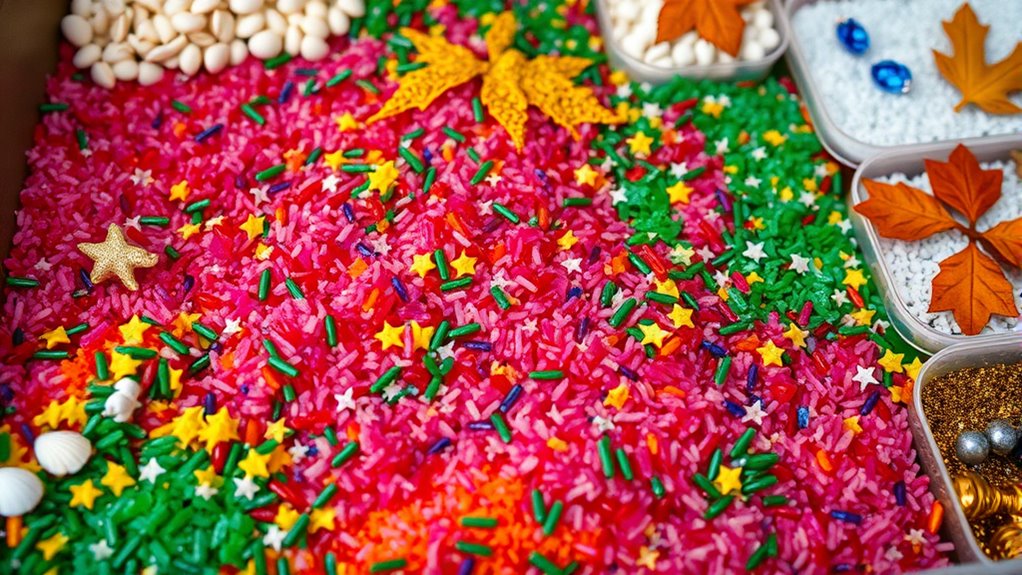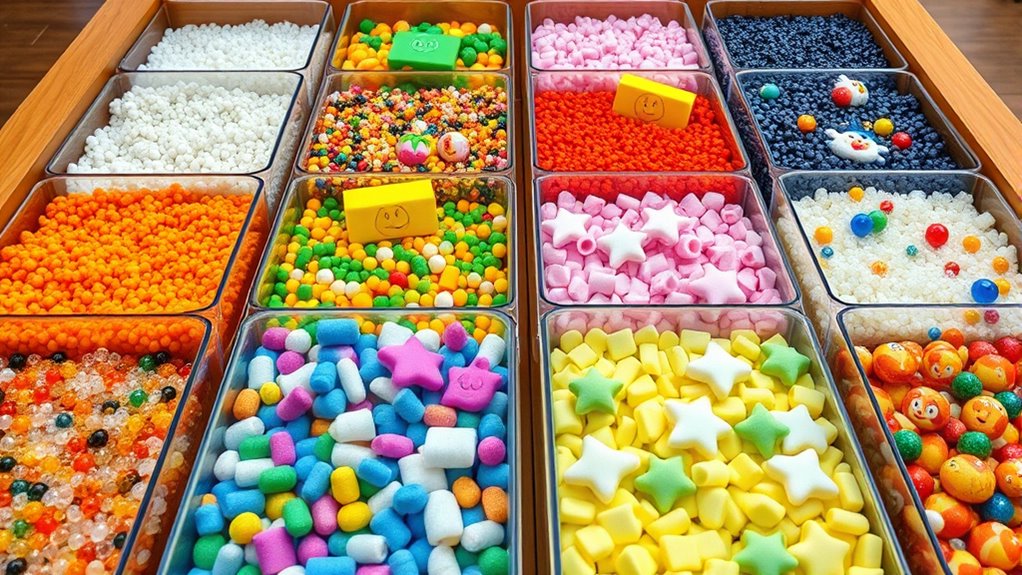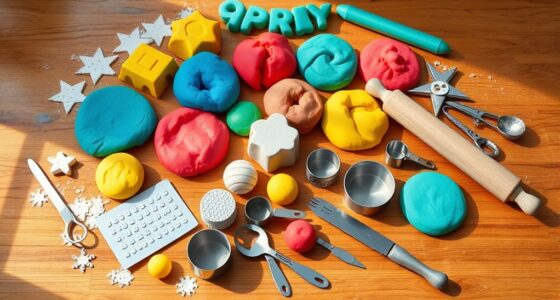To keep children engaged all year, plan a rotation of 30 sensory bin themes that are fun, educational, and seasonally relevant. Use clear bins, labels, and organized storage to make swapping themes easy. Select materials that match each theme, like shells for ocean or leaves for fall. Consider kids’ interests and developmental stages for maximum benefit. Keep the rotation fresh and exciting—exploring this approach can turn play into powerful learning moments. Continue exploring for more ideas.
Key Takeaways
- Plan a diverse calendar of themes to ensure year-round variety and sustained engagement.
- Select age-appropriate, educational, and seasonal themes aligned with children’s interests.
- Organize materials by clear labels and storage to facilitate quick rotation and setup.
- Incorporate sensory-rich textures and materials that match each theme for immersive experiences.
- Adjust themes based on developmental needs to promote ongoing learning and exploration.

Keeping sensory bins on rotation is an effective way to keep children engaged and excited about exploring new textures and materials. When you organize sensory bins thoughtfully, it becomes easier to maintain variety and prevent boredom. Sensory bin organization involves more than just stacking containers; it’s about creating a system that allows you to swap out themes effortlessly. Using clear bins, labeling each with a simple picture or word, and storing them in an accessible location helps streamline the process. This way, you can quickly introduce a new theme without hassle, keeping the learning fresh and stimulating for your little one.
A well-structured track development ensures that each sensory theme builds on previous experiences and encourages progressive learning.
Theme selection strategies are vital in making your sensory bin rotation successful. You want themes that are both educational and fun, aligning with children’s interests and developmental stages. Start by considering seasonal themes, like pumpkins in fall or snowflakes in winter, which naturally connect to what children are experiencing outside. You can also choose themes based on animals, professions, or favorite stories to spark curiosity. Mixing familiar themes with new ideas keeps things interesting and offers opportunities for children to expand their understanding of the world.
To keep the rotation engaging, plan your themes in advance. Create a simple calendar or list that outlines what theme will come next, so you’re never caught off guard. When selecting themes, think about incorporating different textures, colors, and materials that fit the topic. For example, a sea-themed bin might include blue rice, seashells, and small plastic fish. When you incorporate sensory-rich materials aligned with your theme, the experience becomes more immersive and memorable.
In addition, consider the age and interests of your children when choosing themes. Younger children might enjoy themes like animals or toys, while older kids could be more interested in science experiments or cultural topics. Keep a mix of educational and playful themes to balance learning and fun. Remember, the goal isn’t just to fill the bins but to create meaningful, engaging experiences that inspire exploration.
Frequently Asked Questions
How Do I Store Sensory Bins to Keep Them Fresh?
You want to keep your sensory bins fresh, so focus on effective storage solutions and cleaning strategies. Use airtight containers to prevent dust and pests from getting in, and label each bin for easy access. Regularly clean the materials with mild soap and water, and let everything dry completely before refilling. This way, your sensory bins stay hygienic, inviting, and ready for fun whenever you need them.
What Safety Precautions Should I Take With Small Sensory Bin Materials?
While small sensory bin materials spark curiosity, safety must come first. You should follow strict cleaning protocols to prevent germs, and regularly inspect items for damage or mold. Consider allergy considerations by choosing hypoallergenic materials and avoiding known allergens. Keep small pieces out of reach of young children, supervise play, and educate kids about handling materials carefully. These steps help guarantee safe, enjoyable sensory experiences for everyone involved.
How Can I Adapt Sensory Bins for Children With Special Needs?
You can adapt sensory bins for children with special needs by implementing sensory modifications and using adaptive strategies. Simplify materials, choose textures suited to their sensitivities, and include visual cues or auditory supports. Keep the bin at a comfortable height and guarantee supervision. By tailoring the experience, you help children engage safely and meaningfully, fostering exploration and development while accommodating their unique sensory needs.
What Are Budget-Friendly Ideas for Creating Sensory Bin Themes?
Imagine turning everyday items into treasure chests of discovery. You can create budget-friendly sensory bin themes by using DIY fillers like rice dyed with food coloring or pasta painted with vibrant hues. Repurposed objects, such as old buttons, shells, or fabric scraps, add texture and excitement. These inexpensive ideas make play engaging and educational, proving that with a little creativity, you don’t need to spend much to inspire endless exploration.
How Often Should I Refresh or Rotate Sensory Bin Contents?
You should refresh or rotate sensory bin contents regularly to keep your child’s interest alive. Aim for every 1 to 2 weeks, especially if you incorporate seasonal themes and age-appropriate materials. Changing themes keeps play engaging and supports learning. Use seasonal themes to add variety and guarantee materials suit your child’s developmental stage, making sensory play both fun and educational. Regular updates prevent boredom and promote ongoing exploration.
Conclusion
Now that you’ve seen the endless possibilities with rotating sensory bins, imagine the surprises each new theme will bring. Will your child discover something new every week? The excitement builds as you plan the next theme, keeping play fresh and engaging. Stay curious, stay creative—because with so many themes waiting, the adventure never truly ends. Are you ready to see where this journey takes your little explorer next? The best is yet to come.










